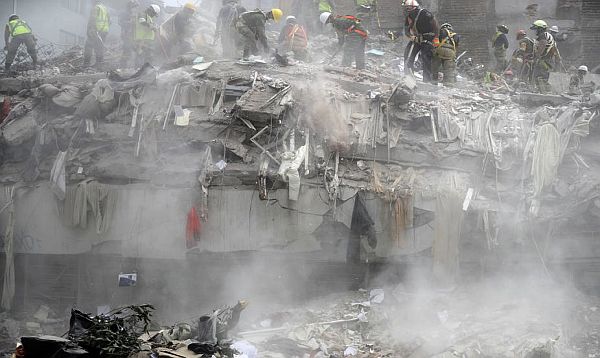In the span of just 11 days, Mexico was devastated by two major earthquakes that destroyed buildings and claimed lives across southern and central Mexico. The official death count was higher than 400 as of Sept. 24, but it will continue to climb as relief efforts turn from rescue work to the recovery of bodies buried in the rubble.
In the days ahead, other measures of the disaster's extent will emerge, including the number of people who were physically injured and the estimated costs to the Mexican economy. No matter the measure, the disaster has clearly devastated many parts of Mexico. But, even then, those measures still obscure the true human cost of the disaster.
Long after the dust settles and new buildings are erected in the place of those that crumbled, tens of thousands of Mexicans will continue to feel the impact of the disaster. Many families, especially those living in poverty, will see their health, well-being and ability to escape poverty worsen for decades. Some will be affected for life.
I study how earthquakes and other natural disasters affect individuals, households and communities – and how to prevent natural hazards from becoming natural disasters in the first place. My research on past earthquakes and other natural disasters shows that these catastrophic events exacerbate social disparities that are much more difficult to repair than the physical destruction.
The hidden consequences of disaster
Despite being the 15th-largest economy in the world Mexico's GDP per capita is only US$18,900, compared to $57,400 in the United States. To make matters worse, more than half of Mexico's population - 67 million people - live in outright poverty.
In southern Mexico, the region most affected by the twin earthquakes, the consequences are likely to be particularly severe: More than 70 percent of people in Guerrero, Oaxaca and Chiapas states live in poverty. Many of those families live in extreme poverty, on less than $2 per person per day.
Losses caused by a natural disaster almost always affect the poor disproportionately and can even cause poverty. Beyond the devastating loss of a loved one, the loss of life is catastrophic for a household that struggles to put food on the table every day. For a poor family, the loss of a breadwinner threatens the future of everyone. For many families, even a modest loss of access to food can lead to malnutrition or affect the long-term health of family members.
And a minor loss in the ability to work or farm profoundly threatens the welfare in households that live close to the subsistence level.
What little savings poor households have are typically tied up in the value of their house, their livestock or some other physical asset. These life savings are often meant to support children through school or to invest agricultural equipment that could substantially increase yields. In developing communities where access to credit is limited, a household's ability to escape poverty depends almost exclusively on savings. In the blink of an eye, the life savings of thousands of Mexican families disappeared this month.While shaking near the epicenters of the two earthquakes measured 8.1 and 7.1 on the Richter scale, both of which can cause even modern buildings to crumble, shaking as low as 5.5 can cause noteworthy property damage. While fully collapsed buildings, fatalities and even injuries were fairly concentrated, at least nine states outside of Mexico City experienced widespread shaking high enough to ruin a poor household's assets.
The loss of property deteriorates a family's ability to sustain the agricultural output upon which their food security and other needs depend. The 2017 earthquakes came during the middle of a growing season for many households. It is too soon to know just how badly the agricultural capacity in southern Mexico has been affected. In other disasters, like the earthquakes in Nepal in 2015, there was a significant loss of crops.
Lower agricultural output will have widespread consequences across the region, inevitably affecting food prices. As the yield drops, or the price of sustaining the yield increases, food prices must rise. Poor families will in turn have a harder time sustaining a sufficient diet, or they will have to reallocate funds intended for long-term improvements to satisfy immediate needs. Many households that sustained no direct damage will be affected.
Beyond the misleading measurements
While the fatality count was higher for the second earthquake, which caused major structural collapses such as the collapse of a primary school with young children trapped inside, the first earthquake will probably have greater long-term consequences. It struck three southern states hardest, each near a 50 percent poverty rate.
The U.S. Geological Survey predicts losses of between $100 million and $1 billion for the second of the earthquakes alone. However, these numbers almost certainly underestimate the long-run consequences that accrue, especially in the case of poor families.
As Mexico moves forward and the world responds, it will be important to remember that the total number of assets lost is not a meaningful indicator of how deeply lives are affected by the disaster. Losses of expensive luxury or vacation homes will quickly increase the total asset losses, while not affecting the food security of their owners.
A $100 loss, while adding little to the total, can mean ruin for a subsistence-level household. Such a loss can cause not only short-term food insecurity but also an inability to escape poverty in the long run.The emergency response will soon end and the world will turn its attention to the next disaster, but Mexican families will still feel the effects of the twin earthquakes for years to come.
This article, written by Morten Wendelbo, a lecturer at the Bush School of Government and Public Service; Research Fellow, Scowcroft Institute of International Affairs; and, Policy Sciences Lecturer, Texas A&M University Libraries, Texas A&M University, was originally published by The Conversation.


